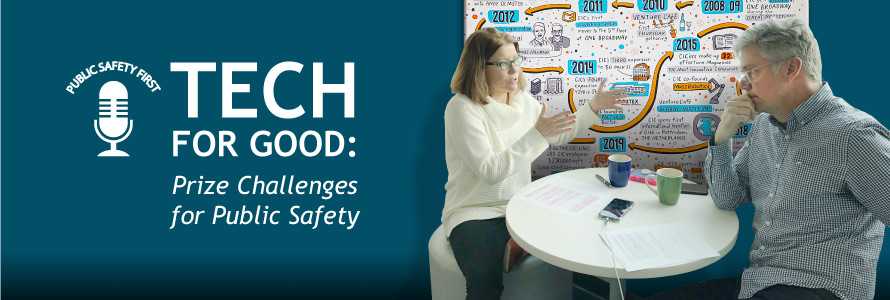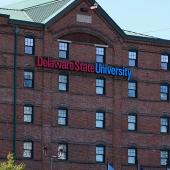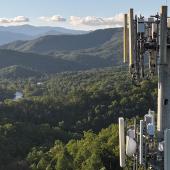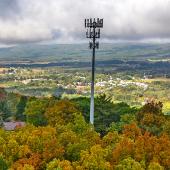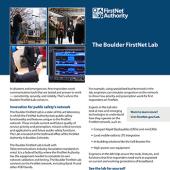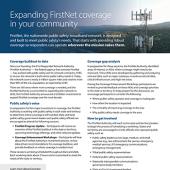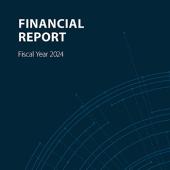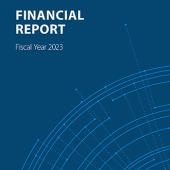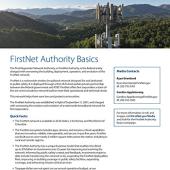Summary
In this episode, Ellen Ryan, Deputy Division Chief for the National Institute of Standards and Technology’s Public Safety Communications Research Division, discusses the division’s Open Innovation program, including current and future grant and prize challenge opportunities.
Guest
Dave Buchanan
FirstNet Authority Executive Director of Public Safety Advocacy
Ellen Ryan
Deputy Division Chief and Open Innovation Program Team Lead, National institute of Standards and Technology’s Public Safety Communications Research Division
Transcript
Preview
Narrator: You're listening to Public Safety First, a podcast to help you learn about the First Responder Network Authority and how you can be part of the future of public safety technology.
And now, your host.
Dave Buchanan: Hi, this is Dave Buchanan, and welcome to the Public Safety First podcast. In today’s episode, I’m sitting down with Ellen Ryan, Deputy Division Chief for the Public Safety Communications Research, or PSCR, Division within NIST [National Institute for Standards and Technology]. Welcome to the podcast, Ellen.
Ellen Ryan: Thank you, Dave. I am very excited to be here and have the opportunity to talk to you this evening.
Narrator: You're listening to Public Safety First, a podcast to help you learn about the First Responder Network Authority and how you can be part of the future of public safety technology.
And now, your host.
Dave Buchanan: Hi, this is Dave Buchanan, and welcome to the Public Safety First podcast. In today’s episode, I’m sitting down with Ellen Ryan, Deputy Division Chief for the Public Safety Communications Research, or PSCR, Division within NIST [National Institute for Standards and Technology]. Welcome to the podcast, Ellen.
Ellen Ryan: Thank you, Dave. I am very excited to be here and have the opportunity to talk to you this evening.
Dave Buchanan: Great. I’m here in your office in Boulder. Delighted to be here, and the FirstNet Authority and PSCR have a long history of working together to advance public safety communications. Can you share with our listeners a little bit more about PSCR – what it is, and what your team does?
Ellen Ryan: Absolutely, I’d be happy to give you a little bit of our history, how we are funding the mission, and how we’ve expanded our research through external participation.
Now, as you know because I know you’ve been working with Dereck [Orr] for a number of years, PSCR traditionally has conducted our research on behalf of government sponsors, such as FirstNet and also DHS [Department of Homeland Security], as well.
However, back in 2012, both FirstNet and PSCR received funding from Congress to research and to assist with the creation of standards and new technology to advance public safety communications, looking forward to the new broadband network that FirstNet was going to be establishing. For the first few years of our funding, we collaborated with FirstNet, telecom manufacturers and public safety communities to determine the technical areas that we needed to focus on. As a result, we established what we refer to as our “portfolios” – our key research areas, and I believe, Dave, you’re probably very familiar with these research areas yourself.
The first one is MCV, or mission-critical voice, taking those features and functionalities that are on the land mobile radio, like push-to-talk and group communications – how do we bring that forward onto a broadband network?
In addition, indoor location-based services, where we really focus on indoor navigation, tracking and mapping for first responders, as well as user interface/user experience, public safety data analytics, and then we also have two cross-cutting areas: cybersecurity and resilient systems. Resiliency means that we have to make sure that that network stays up for public safety.
PSCR was funded 300 million dollars, with the caveat that this funding lasts only through the end of FY [fiscal year] 2022. And even though we have over 100 NIST scientists working on the program, it is a relatively short period of time, and this really is what made us think about how we can engage with external researchers across the world. To date, we’ve awarded over 52 million dollars in grants to 40 external research groups, and we’ve awarded over two million in prize challenges to date, and we’re planning another eight million in the challenges that we launch in FY 2020 and FY 2021.
Dave Buchanan: So, in addition to your role as Deputy Division Chief, you also lead the team for the Open Innovation program. Can you tell me more about what that program is?
Ellen Ryan: Yeah, so, as I mentioned earlier, PSCR has implemented two external research programs – our grant program, and our prize challenge program. And, that’s really the prime program that makes up our Open Innovation program to date. Lots of different people have lots of different ideas about what Open Innovation means. Some people call it citizen science, hackathons, codeathons. In the federal government, and in NIST in particular, we decided to focus in on the Open Innovation tool of prize challenges. Prize challenges, along with our upcoming precommercialization grant and the virtual accelerator program will make up the Open Innovation program. One of the great things about our external research is it allows us to outreach and to build large communities to help solve public safety challenges. A few years ago, our research was done primarily in two locations – Boulder, Colorado, and Gaithersburg, Maryland. But today, we have researchers all over the world, working on problems in telecommunications for public safety. One of our national outreach programs that we’re in the middle of and almost ready to complete is the Tech to Protect challenge.
Dave Buchanan: Yeah, so tell me more about that. I know that that kicked off last year, and you had a number of events in a number of cities. Tell me more about –
Ellen Ryan: Oh, yeah.
Dave Buchanan: – what is Tech to Protect?
Ellen Ryan: It’s a national codeathon that we hosted in ten cities nationwide and online in 2019, and we have the final, national event coming up the first weekend of May 2020. The codeathon itself consisted of ten coding contests that focused on specific challenges and real-life scenarios that first responders face when they’re doing their job. And the best part of it is we’re able to award up to 2.2 million dollars in prize money, including up to 1.7 million to be awarded at the final event.
Dave Buchanan: So, a lot of people are aware of hackathons, you see them in social media and other places. Tell me what made this challenge unique from other hackathons.
Ellen Ryan: Well, we were able to engage FirstNet the Authority early during the concept stage of the challenge, and FirstNet the Authority conceived of and developed four of the ten contests themselves. So, not only did they bring in their expertise as a subject matter expert or a judge, but they were actually the technical leads for four of the ten contests. And, I have to tell you, the FirstNet technical leads have been excellent partners on the project, and I really hope we can collaborate this way more in the future.
Another unique situation that I personally found so gratifying was the ability to have first responders volunteer to be coaches and mentors during the live events. They were actually in the room during the coding challenge itself. I was in the Chicago and the LA events, and we had excellent first responders who gave presentations and met one-on-one with the participants. And I have to tell you, it was fascinating – when the first responders spoke, you could hear a pin drop in the room. It was wonderful to see these young innovators, smart techies, people who really don’t have the opportunity to spend time with first responders to be so motivated and so focused on what the public safety first responders were saying and what improvements they needed in order to do their job in a more safe manner. I’m proud to think we’re making a difference, not only by providing the possible technical solutions, but we’re also raising awareness of the challenges faced by first responders to an entirely new community of energetic, innovative, and technical problem solvers. I could talk all day about the Tech to Protect Challenge.
Dave Buchanan: So, tell me a little bit more about who participated in the codeathon – was it people from the university setting, people from the private sector, who –
Ellen Ryan: It really –
Dave Buchanan: – who wanted to do this?
Ellen Ryan: – it was, it turned out to be all of the above. We had many groups from universities, small businesses. We had a couple of people who worked for large telecom companies, but they came in as their own personal entity. We even had first responders team up, and they provided solutions to some of the contests.
Dave Buchanan: So, what were the results of the codeathon? What kinds of technology were people developing? Was it mostly mobile apps, or were there other types of technology that were the outcome from those things?
Ellen Ryan: Yeah, that’s—the solutions for the ten contests really ranged. Some were mobile applications, some were pre-incident planning tools. We had a couple of RF [radio frequency] measurement tools, and we also had solutions that were methods of streamlining triage during an emergency mass casualty. One of the solutions that I think really showed potential was a solution for one of the pre-incident planning contests. The participant used their mobile phone camera, and they videoed multiple rooms in their house, and then they converted the images into what we call “point clouds,” and using an open-source modeling tool that they found online that had been developed by MIT [Massachusetts Institute of Technology], they created 2D maps and 3D images of the insides of their home. I don’t know if they finished the second part of their work, but they were in the process of overlaying data onto the rooms that could label either a bedroom as being a nursery, or a child’s room, or maybe an elderly parent with mobility problems. They even were going to label areas in the house where pets usually slept. They were also going to work on the quality of their 3D images and see if they could add object detection that first responders might be interested in, such as electrical panels or fire extinguishers, things like that.
Dave Buchanan: So, these ten codeathons occurred in the fall, and now, you mentioned earlier that the national winners are going to be announced this May. What will happen after the challenge ends?
Ellen Ryan: Yeah, so, the national events happened in the fall, and then we had an online submission where we got additional participants that weren’t able to physically come to the national events, and then, in May we have the final event, where we have invited 25 of the best teams that participated to date to demonstrate and pitch their solutions to judges and subject matter experts made up of FirstNet the Authority, FirstNet, Built with AT&T, PSCR, and, of course, most importantly – our first responder community. We’ll be hoping to award up to 1.7 million dollars, to the national winners of the demonstration contest. We are also hoping to award 12 awardees in what we’re calling our Seed and Progress contest, totaling up to 1.2 million dollars. Now, this is the first time that we’ve awarded what we call “commercialization” awards on this large of a scale. Our goal is to assist the participants with the most potential to commercialize their solutions, to continue down what we refer to as the “innovation pipeline.” And we do believe we have some solvers that will be pitching their solutions in May that do have the possibility of actually becoming products and services that can help first responders in the future.
Dave Buchanan: So, what’s the timeframe that you would expect to take place for this commercialization concept? I like that idea, and I can understand how that would, why that should be an area of focus. But what do we believe is the timeframe for –
Ellen Ryan: The timeframe?
Dave Buchanan: – for that to go from concept to commercially available?
Ellen Ryan: So, yeah, I have some thoughts about that, and, I think what I’d like to do now to answer your question is talk about not only our commercialization prize awards that we’re going to be awarding as part of the Tech to Protect program, but I also want to talk to you about our public safety innovation pipeline in general, because I think that’s really what will answer your question as far as commercialization. Over the past few months, PSCR and FirstNet the Authority, we’ve been meeting to collaborate on what we’ve referred to as the public safety innovation pipeline, and it’s really to answer what part of that innovation pipeline does PSCR and FirstNet the Authority each play a major role in assisting the innovators as they solve technical communication challenges facing first responders? For example, the finalists and the award winners that will be coming out of our Tech to Protect program. So, in that spirit, over the next few months, PSCR – we plan to launch two new innovation programs, both focusing on assisting solvers to continue their technical demonstrations and research using new public safety use cases, and also assisting the solvers with their technical business needs. Now, those two programs are called the PSCR Precommercialization Grant Program and Virtual Accelerator Program. For participants to be able to submit proposals into those programs, they have to be a entity that had already been funded by some federal agency, either FirstNet, DHS, NASA, Air Force, for example.
Dave Buchanan: So, let’s talk about the Precommercialization Grant Program. So, what kind of activities does that grant program fund, and what’s the desired outcome for that program?
Ellen Ryan: Well, we noticed that, the awardees coming out of our grant and prize challenge program, they’re really looking at forward-looking research – things that really aren’t available in the market, or will not be available in the market for a number of years. So, we just found that there was this big gap between our solvers on the left end of the pipeline, and what really needs to go on on the commercialization, or the right end, of that innovation pipeline – putting together their business model, getting their executive team together, starting new product development, and really getting the first release of their product out the door. So we felt that if we could come up with what we call a precommercialization program, it helps those early solvers kind of march down toward the commercialization end of the pipeline.
Dave Buchanan: And are these typically designers and developers who have never done anything before in the commercialization realm and this is going to give them the kind of technical assistance and support that will allow them to be successful?
Ellen Ryan: So, when we brainstormed our use cases, and when we really took a hard look at who we wanted to help forward through this program, we envisioned it would be innovators and solvers who have participated in programs like the PSCR grant program and the prize challenge program. So, these are entities that are already doing technical research using public safety use cases, and that’s really what we wanted to promote was that that public safety use case.
Dave Buchanan: So, FirstNet, with its position in the marketplace, has really changed that marketplace for the good for public safety. It’s not just the delivery of a new, dedicated, prioritized broadband network for first responders, it’s this new marketplace for developers and innovators and inventors and designers who otherwise wouldn’t know how to sell to first responders, and couldn’t see the first responder marketplace as something significant – now it is something significant, and I think that’s one of the things that makes this really exciting.
Are you seeing that pivot you described as those who develop technologies for other marketplaces, are they able to see the position then that is now available to them inside the public safety marketplace?
Ellen Ryan: I believe so, and we are starting to see that more and more.
Dave Buchanan: Very cool. I think one of the unexpected benefits of your grant program is we’ve been able to start working with many of them out in the field. You know, our job at the First Responder Network Authority Public Safety Advocacy Team, which I lead, is to engage with public safety really where they are to understand their needs for the network and understand what their future needs are for the network going forward as we consider our enhancements, improvements, and investments in the network. Most recently in Cincinnati, we took advantage of one of your grantees at the University of Cincinnati, who was looking for a way to promote the technologies that they were awarded funding to do some research on, we were looking to do an engagement in the southern Ohio area, and we were able to partner with them to create the Southeast Ohio Technology Summit, where we partnered with your grantee to bring together about 30 first responders from the Cincinnati area. It was terrific. It was a really great way – we’re going to be looking for more ways –
Ellen Ryan: Yeah, the –
Dave Buchanan: – to work with your grantees to do that kind of convening, because people get really excited about the technology, both where it is today, which, as you mention, is something we can talk a lot about, but also where it’s going in the future, which is what you’re focused on, what PSCR’s mission is oriented towards, so I think that was a really exciting –
Ellen Ryan: I love hearing stories like that. You know, we’ve been really fully engaged in our research for about three years now, so we took a step back in December, and we really did a deep dive on data that we’ve collected highlights, stories such as this, we reached out to our grantees, and, you know, we found out from them, you know, what outreach had they been able to do, what publications are they able to get out, into the public, and it was pretty fascinating to see the impact that both FirstNet the Authority and PSCR we are able to have, really, in a relatively short period of time.
Dave Buchanan: Is there anything else we didn’t get a chance to talk about that you want to make sure we consider?
Ellen Ryan: We will be launching four new prize challenges. We have one of our user interface/user experience challenges, and that challenge is called CHARIoT. It’s an augmented reality/IoT challenge, and that will be the first of our 2020 challenges to launch. And then second, a couple weeks after that, we’ll be launching the Public Safety UAS [unmanned aircraft systems] Flight and Endurance challenge, and this will actually be our second drone challenge, and we are already partnering with FirstNet the Authority and FirstNet, Built with AT&T on both of those programs. Next up, we have two public safety data analytics challenges. One is called the ACEPS Challenge, and the second is the De-identification 2.0 Challenge. Now, for these challenges, the participants will be building public safety data sets, and this will be from different types of data, such as video stream, social media streams, audio calls to dispatchers. And they’ll also be developing analytic tools to help first responders successfully use this critical information that comes from these large data sets. So, those are the four new challenges that we’ll be launching in 2020, and then of course, we’re already designing our concepts for the challenges that we’ll be launching in 2021.
Dave Buchanan: Yeah, those sound exciting. I was going to ask, where do we think we’re head in 2021? Is it too early to talk about that, or can we give a preview to – ?
Ellen Ryan: Well, we already have a roadmap lined out around our user interface/user experience portfolio, and even though we have a 2019 challenge, we already have two more user interface/user experience challenges in the pipeline. Our next challenge is going to be around audio challenges, and then we’re going to have a final event in late 2021, where we bring all of these different technologies together.
If you’d like to find out more about any of our past or present or future grant opportunities, prize challenges – please check us out on our website, and please sign up for the PSCR newsletter, and you’ll get firsthand information on all of the programs that we have coming up.
Dave Buchanan: So, I want to thank you for joining me today, Ellen. This was a terrific conversation, I really enjoyed it. And I’ve really enjoyed the relationship we’ve had with PSCR over the last seven years. You know, the PSCR conference, stakeholder conference, before we had a partnership, was the place that first responders and stakeholders went to learn about what FirstNet could be and what it was going to become. And in 2017, when we got our partnership, PSCR was one of the first places you could go and learn what FirstNet actually was in the weeks following our partnership with AT&T. And now in the three years since then, it’s been really exciting to watch this pivot occur, where you can now go to the PSCR conference and learn about what FirstNet will be in the future, and to learn about the technologies and learn about the research and understand where these brilliant developers in the private sector and in the academic world are going to drive the technologies that help first responders do their jobs better and safer. It’s really exciting, and I’m grateful for our partnership, and I just want to thank you again for the time today.
Ellen Ryan: Oh, you’re welcome. Yeah, and I would like to say, I’ve seen a definite shift in the awareness that both FirstNet and PSCR has been able to help raise. When I go out for some of our final events that we have off-site, it is truly amazing the number of people who are now aware of the number of problems that public safety faces – things that they would have never thought of because of what us as a consumer, what we have available to us via our own cell phone. What if we could put half of those apps in the hands of public safety? And once you make people aware of that, they are excited to get on board and to help solve some of those issues.
Dave Buchanan: It’s all very exciting.
Ellen Ryan: Yeah.
Dave Buchanan: Thanks again for your leadership, Ellen, and thanks for your time today.
Ellen Ryan: Thank you, Dave.
Narrator: Thanks for listening today. We're excited to have you join our podcast community. Make sure to subscribe on iTunes, SoundCloud, and YouTube. You can learn more about the First Responder Network Authority at FirstNet.gov and learn about FirstNet products and services at FirstNet.com.


